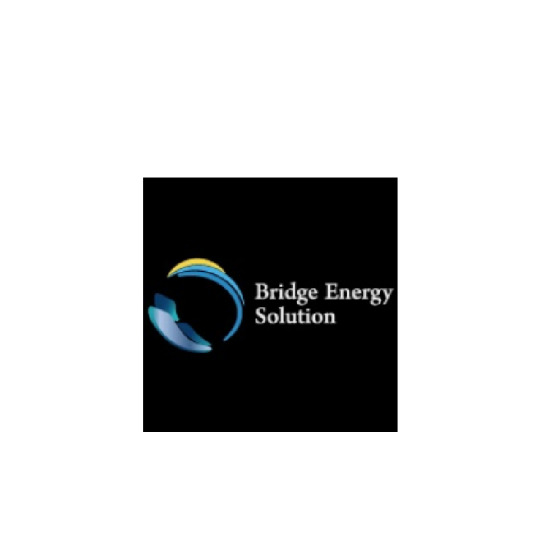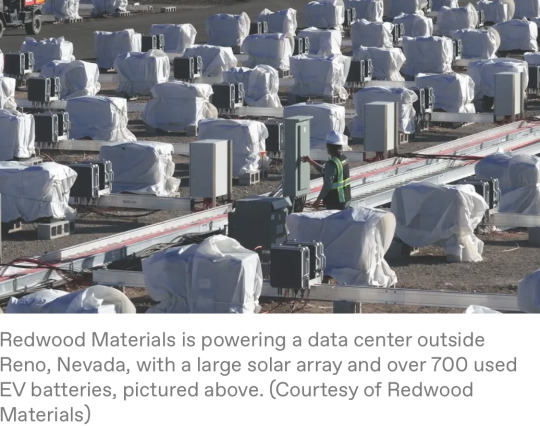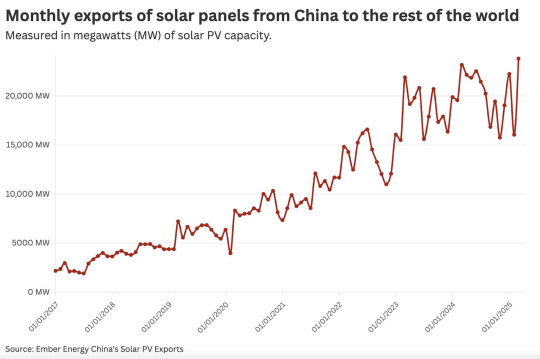#Solar Panel Battery
Explore tagged Tumblr posts
Text
0 notes
Text

Efficient Solar Power Storage: Microtek's Solar Panel Battery Solutions
Microtek offers efficient solar power storage solutions with our solar panel battery technology. Our best inverter battery options provide reliable energy storage and supply for your solar power needs.
1 note
·
View note
Text
"People have been telling stories about renewable energy since the nineteen-seventies, when the first all-solar-powered house opened on the campus of the University of Delaware, drawing a hundred thousand visitors in 1973, its first year, to marvel at its early photovoltaic panels and its solar hot-water system, complete with salt tubs in the basement to store heat overnight. But, even though we’ve got used to seeing solar panels and wind turbines across the landscape in the intervening fifty years, we continue to think of what they produce as “alternative energy,” a supplement to the fossil-fuelled power that has run Western economies for more than two centuries. In the past two years, however, with surprisingly little notice, renewable energy has suddenly become the obvious, mainstream, cost-efficient choice around the world. Against all the big bad things happening on the planet (and despite all the best efforts of the Republican-led Congress in recent weeks), this is a very big and hopeful thing, which a short catalogue of recent numbers demonstrates:
It took from the invention of the photovoltaic solar cell, in 1954, until 2022 for the world to install a terawatt of solar power; the second terawatt came just two years later [in 2024], and the third will arrive either later this year or early next [in 2025 or early 2026].
That’s because people are now putting up a gigawatt’s worth of solar panels, the rough equivalent of the power generated by one coal-fired plant, every fifteen hours. Solar power is now growing faster than any power source in history, and it is closely followed by wind power—which is really another form of energy from the sun, since it is differential heating of the earth that produces the wind that turns the turbines.
Last year, ninety-six per cent of the global demand for new electricity was met by renewables, and in the United States ninety-three per cent of new generating capacity came from solar, wind, and an ever-increasing variety of batteries to store that power.
In March, for the first time, fossil fuels generated less than half the electricity in the U.S. In California, at one point on May 25th, renewables were producing a record hundred and fifty-eight per cent of the state’s power demand. Over the course of the entire day, they produced eighty-two per cent of the power in California, which, this spring, surpassed Japan to become the world’s fourth-largest economy.
Meanwhile, battery-storage capability has increased seventy-six per cent, based on this year’s projected estimates; at night, those batteries are often the main supplier of California’s electricity. As the director of reliability analysis at the North American Electric Reliability Corporation put it, in the CleanTechnica newsletter, “batteries can smooth out some of that variability from those times when the wind isn’t blowing or the sun isn’t shining.” As a result, California is so far using forty per cent less natural gas to generate electricity than it did in 2023, which is the single most hopeful statistic I’ve seen in four decades of writing about the climate crisis.
Texas is now installing renewable energy and batteries faster than California; in a single week in March, it set records for solar and wind production as well as for battery discharge. In May, when the state was hit by a near-record-breaking early-season heat wave, air-conditioners helped create a record demand on the grid, which didn’t blink—more than a quarter of the power came from the sun and wind. Last week’s flooding tragedy was a reminder of how vulnerable the state is to extreme weather, especially as water temperatures rise in the Gulf, producing more moisture in the air; in late June, the director of the state’s utility system said that the chances of emergency outages had dropped from sixteen per cent last summer to less than one per cent this year, mostly because the state had added ten thousand megawatts of solar power and battery storage. That, he said, “puts us in a better position.”
All this is dwarfed by what’s happening in China, which currently installs more than half the world’s renewable energy and storage within its own borders, and exports most of the solar panels and batteries used by the rest of the world. In May, according to government records, China had installed a record ninety-three gigawatts of solar power—amounting to a gigawatt every eight hours. The pace was apparently paying off—analysts reported that, in the first quarter of the year, total carbon emissions in China had actually decreased; emissions linked to producing electricity fell nearly six per cent, as solar and wind have replaced coal. In 2024, almost half the automobiles sold in China, which is the world’s largest car market, were full or hybrid electric vehicles. And China’s prowess at producing cheap solar panels (and E.V.s) means that nations with which it has strong trading links—in Asia, Africa, South America—are seeing their own surge of renewable power.
In South America, for example, where a decade ago there were plans to build fifteen new coal-fired power plants, as of this spring there are none. There’s better news yet from India, now the world’s fastest-growing major economy and most populous nation, where data last month showed that from January through April a surge in solar production kept the country’s coal use flat and also cut the amount of natural gas used during the same period in 2024 by a quarter. But even countries far from Beijing are making quick shifts. Poland—long a leading coal-mining nation—saw renewable power outstrip coal for electric generation in May, thanks to a remarkable surge in solar construction. In 2021, the country set a goal for photovoltaic power usage by 2030; it has already tripled that goal.
Over the past fifteen years, the Chinese became so skilled at building batteries—first for cellphones, then cars, and now for entire electric systems—that the cost of energy storage has dropped ninety-five per cent. On July 7th, a round of bidding between battery companies to provide storage for Chinese utilities showed another thirty per cent drop in price. Grid-scale batteries have become so large that they can power whole cities for hours at a time; in 2025, the world will add eighty gigawatts of grid-scale storage, an eightfold increase from 2021. The U.S. alone put up four gigawatts of storage in the first half of 2024.
There are lots of other technologies vying to replace fossil fuels or to reduce climate damage: nuclear power, hydrogen power, carbon capture and storage; along with renewables, all were boosted by spending provisions in Biden’s Inflation Reduction Act and will be hampered to varying degrees by congressional rollbacks. Some may prove useful in the long run and others illusory, but for now they are statistically swamped by the sheer amount of renewable power coming online. Globally, roughly a third more power is being generated from the sun this spring than last. If this exponential rate of growth can continue, we will soon live in a very different world.
All this suggests that there is a chance for a deep reordering of the earth’s power systems, in every sense of the word “power,” offering a plausible check to not only the climate crisis but to autocracy. Instead of relying on scattered deposits of fossil fuel—the control of which has largely defined geopolitics for more than a century—we are moving rapidly toward a reliance on diffuse but ubiquitous sources of supply. The sun and the wind are available everywhere, and they complement each other well; when sunlight diminishes in the northern latitudes at the approach of winter, the winds pick up. This energy is impossible to hoard and difficult to fight wars over. If you’re interested in abundance, the sun beams tens of thousands of times more energy at the earth than we currently need. Paradigm shifts like this don’t come along often: the Industrial Revolution, the computer revolution. But, when they do, they change the world in profound and unpredictable ways...
In retrospect, it’s reasonably easy to see how fast solar and wind power were coming. But, blinkered by the status quo, almost no one actually predicted it. In 2009, the International Energy Agency predicted that we would hit two hundred and forty-four gigawatts of solar capacity by 2030; we hit it by 2015. For most of the past decade, the I.E.A.’s five-year forecasts missed [underestimated the amount of renewables] by an average of two hundred and thirty-five per cent. The only group that came even remotely close to getting it right was not J. P. Morgan Chase or Dow Jones or BlackRock. It was Greenpeace, which estimated in 2009 that we’d hit nine hundred and twenty-one total gigawatts by 2030. We were more than fifty per cent above that by 2023. Last summer, Jenny Chase, who has been tracking the economics of solar power for more than two decades for Bloomberg, told the Times, “If you’d told me nearly 20 years ago what would be the case now, 20 years later, I would have just said you were crazy. I would have laughed in your face. There is genuinely a revolution happening.”
-via The New Yorker, July 9, 2025
#solar power#solar panels#sun#solarpunk#renewable energy#renewables#climate action#climate news#environment#climate crisis#climate anxiety#climate hope#united states#california#texas#china#india#poland#south america#north america#asia#europe#battery#infrastructure#sustainability#batteries#dawn of the solar age#the solar age#good news#hope
4K notes
·
View notes
Text
How to Extend the Lifespan of Li-Ion Batteries?
Li-ion batteries are essential in powering a wide range of modern devices, from smartphones and laptops to electric vehicles. However, their performance can degrade over time. This guide provides practical tips and strategies to help you maximize the lifespan of your Li-ion batteries, ensuring they remain efficient and reliable.

0 notes
Text
Esteem Energy Introduces a Revolutionary Solar Panel Battery as the Future of Clean Energy Solutions
Esteem Energy introduces a groundbreaking solar panel battery, transforming clean energy solutions. This unique battery helps in the proper storage and utilisation of energy, thus increasing solar power output.
#batteries for solar panel#battery for solar power#battery for solar system#solar battery for house#solar panel battery#batteries for solar panels price#best solar battery australia#solar batteries nsw#solar battery company#solar battery cost australia
0 notes
Text
These tiny solar cells work using a process much like photosynthesis--photons hit the dye, electrons are released and then passed on to a special conductive material that harvests the electricity. They're designed to work in lower light conditions than traditional solar cells and are powerful enough to power small electronics up to the size of a keyboard.
The idea is that these tiny solar cells could replace small batteries for low-energy electronics--they last significantly longer and produce 90% fewer emissions per unit of energy than traditional batteries. Solar cells also remove the emissions from shipping and replacing batteries, although there are potentially some additional environmental costs associated with their production.
This is a really cool step towards having electronics that are powered by renewable energy on an individual level rather than requiring batteries.
#good news#hope#technology#solar energy#solar panels#solar cells#science#climate change#global warming#hopepunk#solarpunk#environment#ecology#batteries#electricity
1K notes
·
View notes
Text
Choosing the Right Solar Inverter: A Guide to Inverter Types and Selection for Your Solar Project

When embarking on a solar energy project, selecting the right Solar inverter is a critical decision that can significantly impact the efficiency and performance of your system. Solar inverters play a pivotal role in converting the direct current (DC) electricity generated by solar panels into alternating current (AC) electricity usable in your home. Here, we'll explore the importance of choosing the appropriate inverter type and provide guidance on selection.
There are primarily three types of Solar inverter to consider:
String Inverters: These are cost-effective and ideal for systems with uniform shading and orientation. They connect all solar panels in a string, but the downside is that if one panel underperforms due to shading or debris, it affects the whole string's output.
Microinverters: A microinverter is attached to each individual solar panel. This configuration ensures that the performance of one panel does not affect the rest. Microinverters are excellent for systems with complex shading issues.
Hybrid Inverters: These inverters are designed for homes with energy storage systems, allowing you to store excess energy in batteries for later use during cloudy days or at night. They offer greater flexibility and self-sufficiency.
To choose the right Solar inverter for your project, consider factors such as your budget, shading conditions, system size, and future expansion plans. Additionally, it's crucial to consult with a qualified solar installer who can assess your specific needs and recommend the most suitable inverter for your solar energy system.
Selecting the right solar inverter is not a one-size-fits-all decision. Understanding the types available and their respective advantages and disadvantages will help you make an informed choice, ensuring the long-term success of your solar project.
For More Information Visit Us-https://www.bessolar.com.au/

0 notes
Text
Dandelion News - July 1-7
Like these weekly compilations? Tip me at $kaybarr1735 or check out my Dandelion Doodles!
1. A Kenya marine biodiversity credit program restores mangroves — and livelihoods

“The organization works directly with local communities, ensuring they benefit from restoration efforts. […] “We invest in livelihood enhancement programs such as smart agriculture, beekeeping and small businesses.” […] COBEC and Seatrees support the [community nurseries] groups by providing some materials used in growing propagules, […] then purchases the saplings for its Seatrees project sites.”
2. Giant river otters return to Argentina after 40-year absence

“The milestone release is also the first time a top predator has been brought back from nationwide extinction in the country. [… M]ore than recovering one species, we want to recover its ecological role in the ecosystem, so we’re measuring the diversity and abundance of [prey] fish species in Iberá, via a procedure that assesses DNA in the water and tells us the species that are present and their numbers.”
3. Countries Have Legal Duty to Protect Human Right to a Stable Climate, Top Court Rules

“States and corporations have binding obligations under international law to address the climate crisis as a human rights emergency, Latin America’s top court on human rights ruled on Thursday. [… States are legally obligated] to take “urgent and effective” action to cut greenhouse gas emissions, to adapt, to cooperate, and to guard against climate disinformation and greenwashing.”
4. A new drug causes nerve tissue to emit light, enabling faster, safer surgery
“[Benvonescein is] safe to use and highlighted longer stretches of nerves than would be visible to the naked eye, improving the odds of operating without causing injury. […] In the operating room, surgeons use microscopes with special lights and filters that illuminate the surgical site at a specific frequency that causes the drug to fluoresce. The nerves appear as wormlike yellowish-green structures that thread through the surrounding tissue.”
5. Redwood Materials built record grid storage project using old EV batteries

”These [solar] panels convert sunlight to electricity and store it in the array of old car batteries [“delivering 63 megawatt-hours of second-life grid storage”], to power a miniature data center that a startup named Crusoe built in the same field as the batteries. […] A battery with just 80% of its original capacity left may get plucked from a vehicle, but it can still function fine for storing solar power.”
June 22-28 news here | (all credit for images and written material can be found at the source linked; I don’t claim credit for anything but curating.)
#good news#hopepunk#kenya#africa#mangroves#trees#reforestation#argentina#river otter#otter#mustelid#animal#biodiversity#climate#climate change#international law#latin america#human rights#surgery#medicine#science#fluorescent#solar panels#solar energy#solar power#electric vehicles#battery#energy storage#circular economy#clean energy
264 notes
·
View notes
Text


team superman secret files
do you ever think about how cute kon's actual canon feelings about superman are. hes just a little guy and he looks up to clark sooooo much 🥺🥺🥺 (also that he feels like john henry is kinda like his uncle... 🩷)
#rimi's comic liveblogging#kon#clark#john henry#superfam#also the little side panel thats like he's SUCH a good imitation of superman that he's even a solar battery! and vulnerable to kryptonite!#WE SWEAR HES JUST AN IMITATION THO HES TOTALLY NOT KRYPTONIAN WE SWEAR WE PROMMY--#its so fucking funny. like. right okay sure i believe you
250 notes
·
View notes
Text
nobody likes a power outage but ya girl IS prepared

#we also have a little lithium ion battery 'generator' to plug hildegard's little habitat into. just in case#and a couple of solar panels to reup the little generator with in case this goes on for awhile#and a fair bit of lamp oil#and a lot of books#psir
61 notes
·
View notes
Text
Why Solar Power Wall Installation is the Best Upgrade for Your Home
When it comes to upgrading your home, what if you could choose an option that not only saves money but also reduces your environmental footprint? Imagine having the power to light up your home during blackouts, lower your electricity bills, and be part of a growing movement toward sustainability. Solar power wall installation is rapidly becoming the go-to choice for homeowners who want to combine innovation, energy efficiency, and environmental responsibility. Let's explore why this upgrade is the best investment for your home.

A Modern Solution to Energy Needs
Solar power walls are a cutting-edge solution that combines solar panels and batteries to store energy for later use. Unlike traditional setups that rely solely on the immediate use of solar energy, a solar power wall allows you to store excess electricity generated during the day. This stored energy can then power your home at night or during times when sunlight is scarce. With the help of a solar batteries installer, the integration of solar panels, batteries, and a solar charge controller ensures your system works seamlessly to maximize energy efficiency.
One interesting fact about solar power walls is that they can significantly reduce your dependency on the grid. According to recent studies, homes equipped with solar panels and battery systems can cut their electricity bills by as much as 50% or more. By having a solar inverter with battery in your setup, you also gain the ability to convert stored energy into usable electricity, ensuring a steady and reliable power supply throughout the day.
Lower Bills and Higher Savings
The rising cost of electricity is a concern for many households. By opting for solar battery installation, you can take control of your energy expenses. A solar power wall allows you to store energy when it’s cheapest and use it during peak hours when electricity rates are higher. This not only reduces your reliance on the grid but also offers substantial savings over time.
Another major advantage of solar power wall installation is the ability to benefit from net metering. This process allows homeowners to sell excess energy generated by their system back to the grid, further offsetting their costs. With the right solar panels and battery system, you’re not just a consumer of electricity — you become a producer too.
A Sustainable and Environmentally Friendly Choice
One of the most compelling reasons to consider solar power wall installation is its environmental benefits. By harnessing the power of the sun, you significantly reduce your carbon footprint. Traditional electricity generation relies heavily on fossil fuels, which release harmful greenhouse gases into the atmosphere. Switching to a solar-powered system means contributing to cleaner air and a healthier planet.
Did you know that over its lifetime, a single solar panel can offset the same amount of carbon dioxide produced by planting dozens of trees? Combining solar panels and battery technology with a solar power wall amplifies this effect, as it reduces waste by storing unused energy rather than letting it go to waste. It’s a win-win for both your home and the environment.
Enhanced Energy Independence
Power outages and blackouts can disrupt daily life, leaving homeowners vulnerable to unexpected interruptions. With a solar power wall installation, you gain enhanced energy independence. During outages, the stored energy in your power wall kicks in, ensuring your home remains powered without relying on the grid.
This feature is especially beneficial for homes in areas prone to natural disasters or frequent power cuts. A solar inverter with a battery ensures that your stored energy is efficiently converted into electricity, keeping essential appliances running when you need them most.
Increasing Your Home’s Value
Solar power wall installation doesn’t just save you money it also adds value to your property. Homes equipped with solar systems, especially those featuring advanced technologies like solar panel battery storage, are considered more desirable in the real estate market. Potential buyers are increasingly prioritizing energy-efficient homes, and having a solar battery installation can set your property apart from the rest.
In fact, studies show that homes with solar power systems sell faster and at a premium compared to those without. A solar power wall is more than just a utility upgrade; it’s an investment that pays dividends when it’s time to sell your home.
Easy Integration and Scalability
Many homeowners hesitate to switch to solar energy, fearing that the installation process will be complex or disruptive. However, modern systems, especially those installed by a qualified solar batteries installer, are designed for easy integration with your existing home setup.
What’s even better is that these systems are scalable. You can start small with a basic setup of solar panels and battery, then expand as your energy needs grow. Whether you want to add more panels, upgrade to a larger solar inverter with a battery, or install a second power wall, the flexibility of these systems ensures they can adapt to your changing requirements.
Long-Term Reliability
Solar power wall systems are built to last. The components, including the solar charge controller and the batteries, are designed to endure harsh weather conditions and deliver consistent performance for years. Most systems come with warranties that ensure peace of mind for homeowners.
Interestingly, while traditional energy sources like coal and gas are subject to market fluctuations, the sun remains a free and abundant resource. By investing in solar power wall installation, you lock in long-term energy savings without worrying about rising fuel costs or depleting resources.
Government Incentives and Rebates
Switching to solar energy isn’t just a smart environmental choice; it’s also a financially rewarding one. Many governments offer incentives, rebates, and tax credits for homeowners who opt for renewable energy solutions like solar battery installation. These programs can significantly reduce the upfront costs of installation, making it more accessible for families on a budget.
Be sure to research local policies and programs in your area. By working with an experienced solar batteries installer, you can navigate these options and maximize your savings while transitioning to cleaner, greener energy.
A Step Toward the Future
Solar power wall installation is more than just an upgrade; it’s a step toward the future. As technology advances, these systems are becoming even more efficient, affordable, and user-friendly. Investing in a solar power wall now means you’re ahead of the curve, reaping the benefits of modern technology while contributing to a more sustainable planet.
Imagine a home that’s self-sufficient, cost-effective, and environmentally responsible. With the integration of solar charge controllers, solar inverters with batteries, and expertly installed solar panels and battery systems, this vision becomes a reality. By making the switch today, you’re not just upgrading your home you’re paving the way for a brighter, cleaner future.
Conclusion
Solar power wall installation is undeniably one of the smartest upgrades you can make for your home. From significant cost savings to enhanced energy independence and environmental benefits, the advantages are compelling. By partnering with a trusted solar batteries installer, you can seamlessly transition to a greener, more efficient energy system that’s tailored to your needs.
The combination of solar panels, batteries, and advanced technologies like solar charge controllers ensures that your system works flawlessly to power your home day and night. Don’t wait to make the switch — start your journey toward a sustainable future today with a reliable solar power wall installation.
#solar batteries installer#Solar Panel Battery#Solar Charge Controller#solar panels and battery#solar battery installation#solar power wall
1 note
·
View note
Text

Excerpt from Sustainability by Numbers:
When it comes to clean energy technologies, China is crushing it.
It dominates the supply chain of the main energy minerals. It’s not only rolling out solar power rapidly at home, it’s also exporting huge amounts of solar panels elsewhere. Take a look at the chart [above], which shows solar PV exports from China to the rest of the world. Increasingly, these panels are going to low-to-middle income countries who are hungry for energy, and will go after whatever’s cheap: that’s Chinese solar.
It produces three-quarters of the world’s batteries. Its largest EV carmaker, BYD, is producing high-quality electric cars for as little as $10,000, and is growing rapidly in many markets across the world. BYD is now targetting the domestic battery market. CATL, the world’s largest battery manufacturer, is pushing the limits of battery technologies, with claims that it can add 300 miles of charge in just 5 minutes (I have some doubts about battery degradation, but I’d obviously love this to be true). The list goes on.
European and American manufacturers are being left in the dirt. One response has been protectionist policies: slapping on tariffs and implementing import quotas. A few newsletters ago, I argued that these were not good interventions if the goal was to increase the number of energy jobs in European and American markets. That’s because most clean energy jobs are in deployment and maintenance rather than manufacturing, and since higher costs slow down the rollout of renewables, increasing prices reduces the total number of people working in clean energy (even if the number working in manufacturing increases).
It produces three-quarters of the world’s batteries. Its largest EV carmaker, BYD, is producing high-quality electric cars for as little as $10,000, and is growing rapidly in many markets across the world. BYD is now targetting the domestic battery market. CATL, the world’s largest battery manufacturer, is pushing the limits of battery technologies, with claims that it can add 300 miles of charge in just 5 minutes (I have some doubts about battery degradation, but I’d obviously love this to be true). The list goes on.
China mainly dominates these markets because it has produced a long-term industrial strategy for these technologies and has honed an optimised, modern supply chain as a result.
The notion that China’s manufacturing output is purely the result of some centralised, governmental program is misguided; it has developed an incredibly competitive market with companies fighting for any edge to cut prices and beat competitors. The solar and battery industries are pretty brutal to be in, with slim margins.
Since China also refines a lot of the minerals and smaller components, its supply chains can become incredibly integrated, which also makes them more optimised.
The second big chunk is labour costs. Now, it’s undeniable that wages in the US are higher than they are in China. But this is not necessarily because Chinese salaries are abysmally low. Yes, they are low by American or European standards, but wages for factory roles are often higher than they are in the US’s southern neighbour, Mexico.
The biggest factor in labour costs is automation. The US uses six times as many workers per GWh (I initially found these numbers pretty shocking and hard to believe), so it’s not surprising that labour costs much more. China has invested heavily in automation, meaning many processes run with very little human input.
This is something else to keep in mind when considering the case for “bringing manufacturing jobs home.” There’s certainly scope for this, but it is at odds with the fact that low costs often rely on automation, not human labour. Especially with the growth of artificial intelligence, some manufacturing jobs could be increasingly vulnerable.
3 notes
·
View notes
Video
youtube
Stay Powered Anywhere: The Ultimate Solar Power Bank for Camping Enthusiasts
Imagine never worrying about dead devices during a camping trip or a long commute. The 20,000mAh Dual USB-C Solar Power Bank is here to keep you juiced up, rain or shine. Built for adventurers and tech lovers alike, this powerhouse combines high capacity, fast charging, and solar readiness to tackle any on-the-go challenge.
Why You’ll Love It:
Solar-Powered Resilience: Harness sunlight to recharge, perfect for off-grid adventures.
Blazing-Fast Charging: Dual USB-C ports and Quick Charge 3.0 deliver rapid power to phones, tablets, or even your camera.
Wireless + Wired Flexibility: Toss your cables—the built-in wireless charger doubles as a phone stand for hands-free streaming.
Travel-Ready Design: Compact (6.3” x 3.1”) and lightweight, it slips into any bag. Choose from vibrant colors or customize it for a unique gift!
Smart Features for Safety: CE/FCC-certified with 10+ protections (overheating, short-circuit, etc.), it’s as reliable as it is powerful. The LED flashlight is a lifesaver for late-night tent setups.
Whether you’re hiking, traveling, or just battling daily errands, this power bank ensures you #StayConnectedEverywhere. Perfect for outdoor lovers, gadget fans, or as a promo gift that actually gets used.
#PowerBank #FastCharging #StayConnected #TechGadgets #PortableCharger #SolarPower #WirelessCharging #TechEssentials #OutdoorGear #MustHave
Grab yours and #ChargeOnTheGo—no outlet required! 🌞🔋
#youtube#Power Bank for camping#Power Bank deals#Power Bank in flight#Power Bank jump starter#Power Bank with Solar panel#Power Bank battery#Power Bank costco#Power Bank for travel#Power Bank laptop
2 notes
·
View notes
Text
Exploring Australia's Finest Solar Panel Battery Options!
Unlock the power of the sun with our guide to Australia's best solar panel battery options! 🌞" Whether you want to lessen your carbon footprint or achieve energy independence, we've compiled a list of high-quality batteries that use solar energy effectively. Join us on a path towards sustainable living and find the ideal solar battery solution for your house or company. Let us embrace green energy together! #SolarPower #GreenLiving #SustainableEnergy.
#Solar Panel Battery#Finest Solar Panel Battery Options#best solar panel battery#Best Solar Panel Battery Solutions#top solar panel battery solutions
0 notes
Text
The Benefits of Residential Solar Solutions in Australia
With the rising costs of electricity and growing concerns about environmental sustainability, more Australian homeowners are turning to solar energy. Devam Solar Australia, with over seven years of experience in solar panel fitting, maintenance, and supply, is committed to providing high-quality Devam Solar Residential Solutions. If you’re considering switching to solar energy, here are some key benefits to keep in mind.

1. Significant Cost Savings
One of the biggest advantages of installing a solar system is the reduction in electricity bills. By generating your own energy, you can cut down on grid dependency and save thousands of dollars in the long run. Additionally, Australia offers various incentives, rebates, and feed-in tariffs that allow homeowners to earn credits for excess energy sent back to the grid.
2. Sustainable and Eco-Friendly
Solar energy is a renewable and clean source of power, reducing your household’s carbon footprint. Unlike fossil fuels, solar panels produce energy without emitting greenhouse gases, making it a great choice for environmentally conscious homeowners. By switching to solar, you contribute to a greener future for Australia.
3. Increase in Property Value
Homes with solar panel installations are in high demand. Many buyers are willing to pay a premium for energy-efficient properties. A solar system not only enhances your home’s value but also makes it more attractive in the competitive real estate market.
4. Energy Independence and Security
With solar power, you can generate your own electricity and reduce reliance on external power sources. This is particularly beneficial in areas with frequent power outages or fluctuating energy prices. Installing a battery storage system allows you to store excess energy for use during nighttime or cloudy days, ensuring an uninterrupted power supply. Devam Solar's Reliable Batteries ensure that you have a consistent and efficient power backup.
5. Low Maintenance Costs
Residential solar systems require minimal maintenance, making them a cost-effective energy solution. Devam Solar provides professional installation and ongoing maintenance services to ensure the efficiency and longevity of your system. With periodic cleaning and occasional check-ups, solar panels can last for over 25 years. Devam Solar Comprehensive Services cover everything from installation to maintenance, ensuring seamless energy solutions for your home.
6. Government Incentives and Rebates
The Australian government offers financial incentives to encourage homeowners to install solar panels. Programs like the Small-scale Renewable Energy Scheme (SRES) provide rebates that significantly reduce the upfront cost of solar system installation. Additionally, state-based incentives further enhance affordability, making Affordable Solar Solutions Victoria a reality for many homeowners.
7. Support for a Sustainable Future
By switching to solar power, you play a crucial role in Australia’s transition towards renewable energy. Investing in solar solutions contributes to reducing the demand for non-renewable energy sources, promoting a cleaner and more sustainable environment for future generations. NetCC Solar Solutions in Victoria provides advanced solar technologies that enhance energy efficiency and sustainability.
Why Choose Devam Solar?
With over seven years of expertise in the Australian solar industry, Devam Solar specializes in high-quality Devam Solar Residential Solutions and Devam Solar Commercial Solutions. Our team is dedicated to delivering efficient and reliable solar solutions tailored to meet your specific energy needs. Whether you’re looking to reduce electricity costs, enhance property value, or contribute to a greener planet, we have the right solution for you.
We also offer Solar Batteries & Heat Pump Services Australia, ensuring that you get the best power storage solutions for your needs. As part of devam group, we integrate innovative technologies to deliver the best solar energy solutions, including NetCC Solar Solutions and Commercial Solar Solutions.
Make the smart switch today! Contact Devam Solar to learn more about our Devam Solar Residential Solutions and take the first step towards energy independence with our Affordable Solar Solutions Victoria.
#Solar#Solar Solutions#Solar Australia#Solar Panels#Residential Solar#Home Solar#Devam Solar#Devam Solar Australia#Devam Solar Residential Solutions#Power Your Business With Devam Solar#Devam Solar Commercial Solutions#Devam Solar Comprehensive Services#Devam Solars Reliable Batteries#Solar Batteries & Heat Pump Services#devam group#Netcc Solar Solutions#Affordable Solar Solutions Victoria#Solar Batteries & Heat Pump Services Australia#devam technologies#Solar Batteries & Heat Pump Services Victoria#affordable solar solutions#NetCC Solar Solutions in Victoria#Commercial Solar Solutions
3 notes
·
View notes